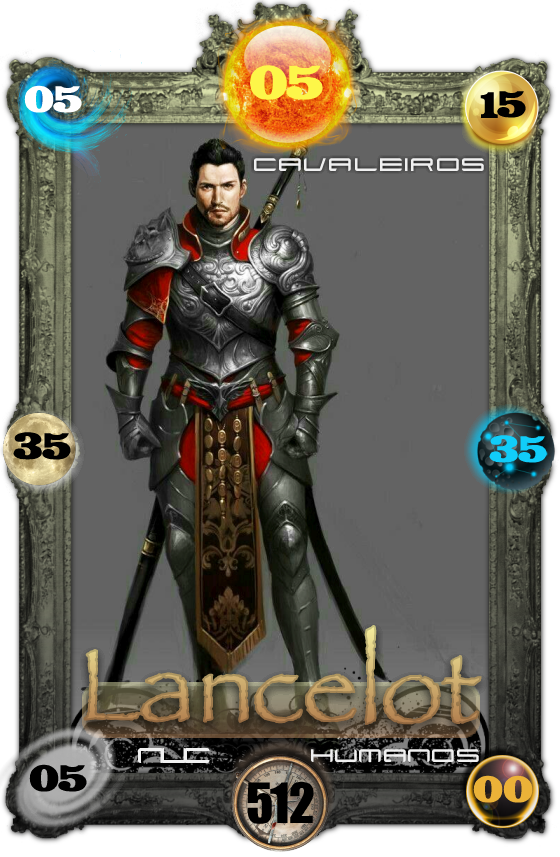Sir Lancelot
Knights - Humans
Card 512
-
Knights of the Round TableThe Knights of the Round Table are from a very evolved society in the art of war.
At the beginning of our history, although they follow different causes and can fight against each other, these knights are bound to the king of prophecy and will follow him. This king is Arthur.
Note: When a knight and Arthur meet, the knight will know that he must follow him.* These knights, when they follow the same cause, can group to the attack.
(but if they run into Arthur, they will pass by immediately.)
Battle Area:
- Water = 00
- Earth = 35
- Heaven = 00
Attack and Defense
- Wisdom = 15
- Dexterity and Strength = 35
- Powers = 00
- Fire = 00
Game
NUC Cards is a board game. With trays representing the opponents' lands and the battlefield.
The characters exist timelessly. In one era, historical, mythological and literary characters meet in this game.
An epic oxygen game of great kings, notable warriors, heroes and anti-heroes, mighty magicians and gods between creatures and beings ...
Sign up and get access to rules details and more cards.
Collect!
Sir Lancelot
-
Knights of the Round Table
He is better known today for having chirped King Arthur than for his role in the quest for the Holy Grail. Lancelot's life is told in several medieval novels, usually as a secondary character. His first "serious" appearance occurs in the text "Le Chevalier de La Charette" by Chretien de Troyes, dating from the twelfth century, but it was during the thirteenth century that he really became known in the European courts in the cycle called "Vulgate "In the" Prose of Lancelot ".
The literary origins of Lancelot are somewhat obscure. Before his appearance in the poems of Chrétien de Troyes, Lancelot is practically an illustrious unknown. The scholar Roger Sherman Loomis suggests that Lancelot is related to Welsh hero Llwch Llenlleawg ("Llwch of the Awesome Hand") of the cycle Culhwch and Olwen.
In Chretien's poem "Erec and Enide", the name Lancelot appears as the third character on a list of knights at King Arthur's court. The fact that Lancelot's name follows Gawain and Erec indicates the presumed importance of the knight in court, even though he does not figure prominently in Chretien's tale. Lancelot reappears in "Cligès", also by Chrétien. Here, Lancelot takes on a more important role as one of the knights Cliges must overcome in his quest.
It is not until "Le Chevalier de La charette", however, that Lancelot becomes the protagonist. In this text, he is presented as the most formidable knight at King Arthur's court. His adulterous relationship with the Queen is also introduced in this tale for the first time. According to Pamela Raabe, in the work of Chrétien de Troyes, Lancelot is portrayed as not only the fairest and perfect of the knights, but all who find him also describe him as exceptionally perfect. The problem is that the critics were unable to reconcile their "state of sanctity" with their obvious adultery with Guinevere. How can the consummation of lovers be considered a "sanctified case" when it is equally adulterous?
Although Lancelot is later associated with the quest for the Grail, Chrétien does not include it in his final novel, Le conte du graal. In this story, which introduces the Grail allegory in medieval literature, Percival is the sole grail seeker. Lancelot's participation in the Grail legend is first published in the poem Perlesvaus written between 1200 and 1210.
NUC Cards ® 2019
Reasoning and strategy.
An advanced game of underground strategy in generation.















